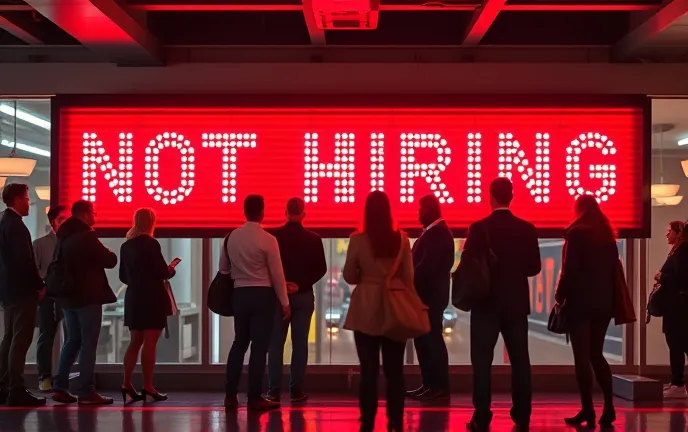For months, the US job market felt unusually quiet — like corporate America was standing perfectly still, waiting for something to give — not really hiring, but not firing either.
But that period of calm is officially over as a surge of job cuts is now hitting some of America’s biggest and most famous companies, with the online retail giant Amazon the latest to announce a significant reduction in its workforce.
The layoffs are adding to a sense of anxiety among workers and are a clear sign that, despite some pockets of strength, the US job market is in a period of deep uncertainty.
This comes as the broader job market is in what some analysts have described as a “no-hire, no fire” standstill, with many companies limiting new hiring to only a few specific roles.
The trend is clear: big layoffs are piling up. Here are some of the companies making the cuts:
Amazon
Amazon has announced that it will cut about 14,000 corporate jobs, which represents close to 4% of its workforce.
The online retail giant is ramping up its spending on artificial intelligence (AI) while trimming its costs in other areas.
In a letter to employees, the company said most of the affected workers would be given 90 days to find a new position internally.
CEO Andy Jassy has previously stated that he expects generative AI to reduce the company’s corporate workforce in the coming years.
UPS
United Parcel Service (UPS), an American package delivery giant that was founded in 1907, has cut about 34,000 jobs since the start of 2025, a figure that is notably higher than the roughly 20,000 cuts it had forecast earlier.
The layoffs are part of a broader turnaround effort at the shipping giant, which has also closed its daily operations at 93 of its buildings in the first nine months of the year.
Target
The US retail giant Target announced last week that it would eliminate about 1,800 corporate positions, its first major round of layoffs in a decade.
The cuts were part of a wider streamlining effort, with the company’s incoming CEO, Michael Fiddelke, noting that “too many layers and overlapping work have slowed decisions.”
The retailer has been battling a persistent sales slump and has seen its comparable sales either fall or remain flat in nine of the past eleven quarters.
Nestlé
In mid-October, the Swiss food giant Nestlé said it would be cutting 16,000 jobs globally over the next two years.
The company stated that the move was part of a wider cost-cutting initiative aimed at reviving its financial performance.
Nestlé, like many in the consumer goods sector, has been facing significant headwinds from rising commodity costs for ingredients like coffee and cocoa, as well as pressures from US-imposed tariffs.
Lufthansa
In September, the German airline Lufthansa Group announced it would shed 4,000 jobs by 2030, pointing directly to the adoption of artificial intelligence, digitalization, and the consolidation of work among its member airlines.
The company specified that the cuts would be focused on administrative rather than operational roles, with most of the affected jobs located in Germany.
Novo Nordisk
Also in September, the Danish pharmaceutical company Novo Nordisk said it would cut 9,000 jobs, representing about 11% of its total workforce.
The maker of the popular drugs Ozempic and Wegovy said the layoffs were part of a wider restructuring as it works to increase sales of its obesity and diabetes medications in the face of rising competition in the market.
Intel
The struggling chipmaker Intel has moved to shed thousands of jobs as it works to revive its business and catch up to its high-flying rivals, Nvidia and Advanced Micro Devices.
In a July memo to employees, CEO Lip-Bu Tan said that Intel expected to end the year with 75,000 “core” workers.
This represents a dramatic reduction from the 99,500 core employees the company reported at the end of last year and is part of a broader 15% workforce reduction plan.
Microsoft
Microsoft has conducted two major rounds of layoffs in 2025, for a total of 15,000 jobs. In May, the company began laying off about 6,000 workers across its workforce.
Just months later, the tech giant announced it would be cutting another 9,000 positions, marking its biggest round of layoffs in more than two years.
The company has cited “organizational changes” and a push to trim management layers, but the cuts also come as it is spending tens of billions of dollars to compete in the AI space.
Why is this happening now?
The reasons for the recent wave of layoffs are varied and complex.
Some companies have pointed to rising operational costs, including the impact of President Donald Trump’s new tariffs and significant shifts in consumer spending.
Others have cited a need for a broader corporate restructuring.
A key emerging theme is the massive and costly race for artificial intelligence. Some experts believe that the immense cost of investing in AI is forcing companies to make painful trade-offs in other areas, including employment.
“It’s not so much AI directly taking jobs, but AI’s appetite for cash that might be taking jobs,” Jason Schloetzer, a professor at Georgetown University’s McDonough School, told The Independent.
This private-sector anxiety is being compounded by the uncertainty in the public sector.
The ongoing US government shutdown, which is now nearing its fourth week, has seen hundreds of thousands of federal workers go without pay, a development that is further impacting sentiment around the job market as a whole.
“I think there’s a question mark around the long-term stability everywhere,” said Schloetzer.
The post Amazon, Target, UPS & more: why job cuts are hitting major US companies in 2025 appeared first on Invezz

